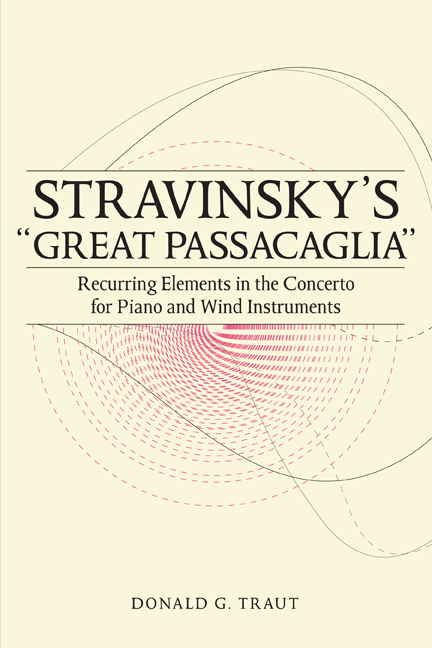Book contents
- Frontmatter
- Dedication
- Contents
- Acknowledgments
- Introduction
- 1 Context and Composition
- 2 Concerto as Catalyst
- 3 Analytical Tools and Recurring Elements
- 4 Counterpoint and Tonality in the First Movement
- 5 Tetrachords and Tritones in the Largo
- 6 Points of Imitation in the Finale
- Conclusion
- Appendix
- Notes
- Bibliography
- Index
Conclusion
Published online by Cambridge University Press: 12 August 2020
- Frontmatter
- Dedication
- Contents
- Acknowledgments
- Introduction
- 1 Context and Composition
- 2 Concerto as Catalyst
- 3 Analytical Tools and Recurring Elements
- 4 Counterpoint and Tonality in the First Movement
- 5 Tetrachords and Tritones in the Largo
- 6 Points of Imitation in the Finale
- Conclusion
- Appendix
- Notes
- Bibliography
- Index
Summary
At the start of this book, I touched on several motivations that helped shape this study of Stravinsky's Concerto. Among them is the need for analytic work that approaches the piece in its entirety and studies all three movements. As the preceding analyses illustrate, there are many compositional elements that provide connective material. Considering this, Stravinsky's comment that the piece is “a sort of great passacaglia” provides an interesting framework. The analyses also provide useful responses to critics like Schenker, who claimed the Concerto lacks coherence, and Lambert, who dismissed it as unworthy of serious consideration. What remains is to pull together observations from each of the individual movements and illustrate the extent to which the four Recurring Elements do in fact create unity.
Summary of the Four Recurring Elements
In Chapter 3, I introduced four Recurring Elements (RE): a repeated-note melody (RE 1), a descending tetrachord (RE 2), a tritone-based sonority (RE 3), and a stepwise bass line (RE 4). I illustrated how all these elements appear in the opening four measures of the piece as a sort of summary. Further, I connected two of the elements—the melody and the tetrachord—directly to Stravinsky's earliest compositional sketch. My goal was to show how these four elements, originating in the sketch page and summarized in the opening measures, actually function throughout the piece, transformed and reused in different musical settings. The following gauges this effect for each of the four Recurring Elements.
Recurring Element 1: The Calendar Tune
The primary feature of the calendar sketch page (fig. 1.1) is a three-measure melodic idea that I have dubbed RE 1. Analysis of the idea focused on three distinct motivic figures—a repeated note (x), a turn figure (y), and a sixteenth-note run (z). As example C.1 shows, overt references to RE 1 occur in all three movements. Motive z is absent from this graphic, apparently reserved for the first movement, but references to motives x and y are plentiful. Example C.1b shows a gesture from the solo passage addressed in chapter 4. In example C.1c, this same gesture appears transposed again, this time from the developmental section.
- Type
- Chapter
- Information
- Stravinsky s "Great Passacaglia"Recurring Elements in the Concerto for Piano and Wind Instruments, pp. 129 - 138Publisher: Boydell & BrewerPrint publication year: 2016

